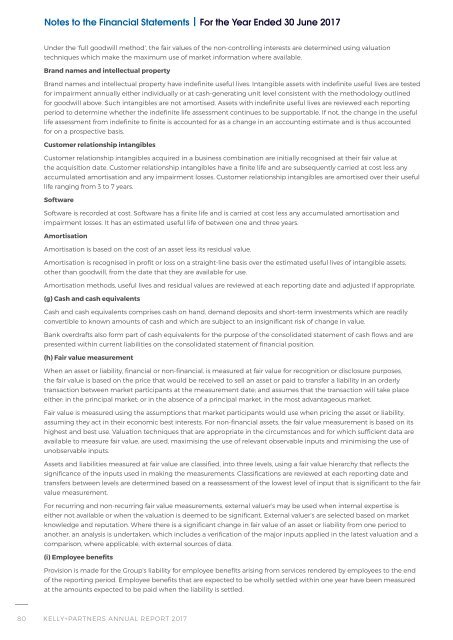070917_KPGHL_Annual Report 2017_final_PREVIEW
You also want an ePaper? Increase the reach of your titles
YUMPU automatically turns print PDFs into web optimized ePapers that Google loves.
Notes to the Financial Statements | For the Year Ended 30 June <strong>2017</strong><br />
Under the 'full goodwill method', the fair values of the non‐controlling interests are determined using valuation<br />
techniques which make the maximum use of market information where available.<br />
Brand names and intellectual property<br />
Brand names and intellectual property have indefinite useful lives. Intangible assets with indefinite useful lives are tested<br />
for impairment annually either individually or at cash‐generating unit level consistent with the methodology outlined<br />
for goodwill above. Such intangibles are not amortised. Assets with indefinite useful lives are reviewed each reporting<br />
period to determine whether the indefinite life assessment continues to be supportable. If not, the change in the useful<br />
life assessment from indefinite to finite is accounted for as a change in an accounting estimate and is thus accounted<br />
for on a prospective basis.<br />
Customer relationship intangibles<br />
Customer relationship intangibles acquired in a business combination are initially recognised at their fair value at<br />
the acquisition date. Customer relationship intangibles have a finite life and are subsequently carried at cost less any<br />
accumulated amortisation and any impairment losses. Customer relationship intangibles are amortised over their useful<br />
life ranging from 3 to 7 years.<br />
Software<br />
Software is recorded at cost. Software has a finite life and is carried at cost less any accumulated amortisation and<br />
impairment losses. It has an estimated useful life of between one and three years.<br />
Amortisation<br />
Amortisation is based on the cost of an asset less its residual value.<br />
Amortisation is recognised in profit or loss on a straight‐line basis over the estimated useful lives of intangible assets,<br />
other than goodwill, from the date that they are available for use.<br />
Amortisation methods, useful lives and residual values are reviewed at each reporting date and adjusted if appropriate.<br />
(g) Cash and cash equivalents<br />
Cash and cash equivalents comprises cash on hand, demand deposits and short‐term investments which are readily<br />
convertible to known amounts of cash and which are subject to an insignificant risk of change in value.<br />
Bank overdrafts also form part of cash equivalents for the purpose of the consolidated statement of cash flows and are<br />
presented within current liabilities on the consolidated statement of financial position.<br />
(h) Fair value measurement<br />
When an asset or liability, financial or non‐financial, is measured at fair value for recognition or disclosure purposes,<br />
the fair value is based on the price that would be received to sell an asset or paid to transfer a liability in an orderly<br />
transaction between market participants at the measurement date; and assumes that the transaction will take place<br />
either: in the principal market; or in the absence of a principal market, in the most advantageous market.<br />
Fair value is measured using the assumptions that market participants would use when pricing the asset or liability,<br />
assuming they act in their economic best interests. For non‐financial assets, the fair value measurement is based on its<br />
highest and best use. Valuation techniques that are appropriate in the circumstances and for which sufficient data are<br />
available to measure fair value, are used, maximising the use of relevant observable inputs and minimising the use of<br />
unobservable inputs.<br />
Assets and liabilities measured at fair value are classified, into three levels, using a fair value hierarchy that reflects the<br />
significance of the inputs used in making the measurements. Classifications are reviewed at each reporting date and<br />
transfers between levels are determined based on a reassessment of the lowest level of input that is significant to the fair<br />
value measurement.<br />
For recurring and non‐recurring fair value measurements, external valuer’s may be used when internal expertise is<br />
either not available or when the valuation is deemed to be significant. External valuer’s are selected based on market<br />
knowledge and reputation. Where there is a significant change in fair value of an asset or liability from one period to<br />
another, an analysis is undertaken, which includes a verification of the major inputs applied in the latest valuation and a<br />
comparison, where applicable, with external sources of data.<br />
(i) Employee benefits<br />
Provision is made for the Group's liability for employee benefits arising from services rendered by employees to the end<br />
of the reporting period. Employee benefits that are expected to be wholly settled within one year have been measured<br />
at the amounts expected to be paid when the liability is settled.<br />
80 KELLY+PARTNERS ANNUAL REPORT <strong>2017</strong>


